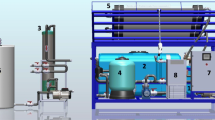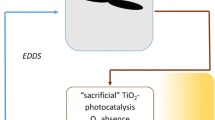Abstract
The effectiveness of photocatalytic treatment under solar light irradiation of waste nutrient solution emitted from a soil-less cultivation system of tomatoes planted in rice hull substrate was investigated from the viewpoint of conservation-oriented agriculture. As a model experiment, the phytotoxically active extract from rice hulls was treated with a TiO2-coated porous alumina filter irradiated with ultraviolet light at an intensity of 2.0 mW/cm2, and the phytotoxic activities before and after irradiation were evaluated from the germination rate of lettuce seeds. The germination rate was 0 % before irradiation, demonstrating the strong inhibitory effect of the rice hull extract, but recovered to 100 % after 4 days of irradiation. The growth of tomatoes planted in rice hull substrate under actual cultivation conditions was also observed in six repeated experiments over a 3-year period by comparing tomatoes grown in a closed soil-less cultivation system with photocatalytically treated waste nutrient solution under solar light (photocatalytically treated system), with tomatoes grown in a closed system with untreated waste nutrient solution (untreated system). The results showed that tomato growth in the photocatalytically treated system was significantly higher than that in the untreated system in six experiments over 3 years, and yields in the photocatalytically treated system were comparable to those in a currently used open cultivation system using rockwool substrate. These results suggest that incorporating photocatalytic treatment of waste nutrient solution under solar light irradiation will allow conservation-oriented closed soil-less cultivation systems to be realized.







Similar content being viewed by others
Abbreviations
- TOC:
-
Total organic carbon
- UV:
-
Ultraviolet
- EC:
-
Electrical conductivity
References
Chung IM, Hahn SJ, Ahmad A (2005) Confirmation of potential herbicidal agents in hulls of rice Oryza sativa. J Chem Ecol 31:1339–1352. doi:10.1007/s10886-005-5290-5
Daum D, Schenk MK (1998) Influence of nutrient solution pH on N2O and N2 emissions from a soilless culture system. Plant Soil 203:279–287. doi:10.1023/A:1004350628266
Fujishima A, Hashimoto K, Watanabe T (1999) TiO2 photocatalysis: fundamentals and applications. BKC, Tokyo
Hashimoto K, Irie H, Fujishima A (2005) TiO2 photocatalysis: a historical overview and future prospects. Jpn J Appl Physiol 44:8269–8285. doi:10.1143/JJAP.44.8269
Heller A (1995) Chemistry and applications of photocatalytic oxidation of thin organic films. Acc Chem Res 28:503–508. doi:10.1021/ar00060a006
Herrmann JM (1999) Heterogeneous photocatalysis: Fundamentals and applications to the removal of various types of aqueous pollutants. Catal Today 53:115–129. doi:10.1016/S0920-5861(99)00107-8
Hoffmann MR, Martin ST, Choi W, Bahnemann DW (1995) Environmental applications of semiconductor photocatalysis. Chem Rev 95:69–96. doi:10.1021/cr00033a004
Ito T (1999) The greenhouse and hydroponic industries of Japan. Acta Hortic 481:761–764
Jung V, Olsson E, Casperson S, Asp H, Jensen P, Alsanius BW (2004) Response of young hydroponically grown tomato plants to phenolic acids. Sci Horticult 100:23–37. doi:10.1016/j.scienta.2003.08.011
Kanagawa agricultural technology center (2007) List of standard index on agricultural production from data of Kanagawa Prefecture in Japan. (in Japanese) http://www.agri.pref.kanagawa.jp/nosoken/nosoken.asp
Kato T, Kabuto C, Sasaki N, Tsunagawa M, Aizawa H, Fujita K, Kato Y, Kitahara Y (1973) Momilactons, growth inhibitors from rice, Oryza sativa L. Tetrahedron Lett 39:3861–3864. doi:10.1016/S0040-4039(01)87058-1
Kato T, Tsunakawa M, Sasaki N, Aizawa H, Fujita K, Kitahara Y, Takahashi N (1977) Growth and germination inhibitors in rice hunks. Phytochemistry 16:45–48. doi:10.1016/0031-9422(77)83010-0
Kato-Noguchi H, Ino T, Ota K (2008) Secretion of momilacton A from rice roots to the rhizospere. J Plant Physiol 165:691–696. doi:10.1016/j.jplph.2007.07.018
Kong CH, Li HB, Hu F, Xu XH, Wang P (2006) Allelochemicals released by rice roots and residues in soil. Plant Soil 288:47–56
Lee J, Choi W, Yoon J (2005) Photocatalytic degradation of N-nitrosodimethylamine: mechanism, product distribution, and TiO2 surface modification. Environ Sci Technol 39:6800–6807. doi:10.1021/es0481777
Lettmanna C, Hildenbrandb K, Kisch H, Macykc W, Maier WF (2001) Visible light photodegradation of 4-chlorophenol with a coke-containing titanium dioxide photocatalyst. Appl Catal B Environ 32:215–227. doi:10.1016/S0926-3373(01)00141-2
Noguchi H, Nakajima A, Watanabe T, Hashimoto K (2003) Design of a photocatalyst for bromate decomposition: Surface modification of TiO2 by pseudo-boehmite. Environ Sci Technol 37:153–157. doi:10.1021/es0258733
Ollis DF, Pelizetti E, Serpone N (1991) Photocatalyzed destruction of water contaminants. Environ Sci Technol 25:1523–1529. doi:10.1021/es00021a001
Pagliaccia D, Ferrin D, Stanghellini ME (2007) Chemo-biological suppression of root-infecting zoosporic pathogens in recirculating hydroponic systems. Plant Soil 299:163–179. doi:10.1007/s11104-007-9373-7
Pichat P, Vannier S, Dussand J, Rubis JP (2005) Assessment of solar photocatalysis to purify on-site rinse waters from tractor cisterns used in grapevine pest control: field experimentation. Water Sci Technol 52:223–230
Ruijs MNA (1994) Economic evaluation of closed production system in glasshouse horticulture. Acta Hortic 340:87–94
Sun RD, Irie H, Nishikawa T, Nakajima A, Watanabe T, Hashimoto K (2003) Suppressing effect of CaCO3 on the dioxins emission from poly (vinyl chloride) (PVC) incineration. Polym Degrad Stabil 79:253–256. doi:10.1016/S0141-3910(02)00288-4
Sunada K, Ding XG, Utami MS, Kawashima Y, Miyama Y, Hashimoto K (2008) Detoxification of phytotoxic compounds by TiO2 photocatalysis in a recycling hydroponic cultivation system of asparagus. J Agric Food Chem 56:4819–4824. doi:10.1021/jf8001075
Takahashi N, Kato T, Tsunagawa M, Sasaki N, Kitahara Y (1976) Mechanisms of dormancy in rice seeds. II. New growth inhibitors, momilactone-A and B isolated from the hulls of rice seeds. Jpn J Breed 26:91–98
Van Os EA (1995) Engineering and environmental aspects of soilless growing systems. Acta Hortic 396:25–32
Yu JQ, Matsui Y (1993) Extraction and identification of the phytotoxic substances accumulated in the nutrient solution for the hydroponic culture of tomato. Soil Sci Plant Nutr 39:691–700
Yu JQ, Komada H (1999) Hinoki (Chamaecyparis obtusa) bark, a substrate with anti-pathogen properties that suppress some root diseases of tomato. Sci Hortic 81:13–24. doi:10.1016/S0304-4238(98)00262-3
Yu JQ, Lee KS, Mastui Y (1993) Effect of the addition of activated charcoal to the nutrient solution on the growth of tomato in hydroponic culture. Soil Sci Plant Nutr 39:13–22
Acknowledgments
The authors thank Mr. Greg Newton for the critical reading of this manuscript. We are also grateful to Mr. Shigeki Henmi and Mr. Yoshihumi Kumazawa for their support during the field experiments. This work was supported by a research grant for utilizing advanced technologies in agriculture, forestry and fisheries from the Agriculture, Forestry and Fisheries Research Council.
Author information
Authors and Affiliations
Corresponding author
Additional information
Responsible editor: Peter Christie.
Rights and permissions
About this article
Cite this article
Miyama, Y., Sunada, K., Fujiwara, S. et al. Photocatalytic treatment of waste nutrient solution from soil-less cultivation of tomatoes planted in rice hull substrate. Plant Soil 318, 275–283 (2009). https://doi.org/10.1007/s11104-008-9837-4
Received:
Accepted:
Published:
Issue Date:
DOI: https://doi.org/10.1007/s11104-008-9837-4




